A well-equipped toolbox is essential for completing jobs around the home — everything from hanging a picture frame to putting together furniture or doing major renovations. Here are the tools everyone should own, from the most minimalist toolbox to a kit for the experienced DIYer.
Photos by mtneer_man, Daren, and Mark Hunter.
How To Stock Your Toolbox
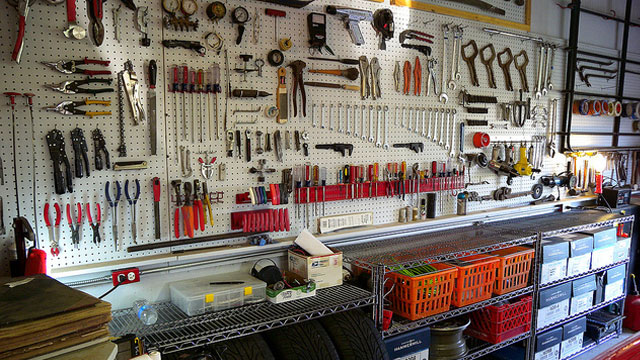
First, let’s talk about how you’re going to amass all these handy tools. Buying them all at once could cost you hundreds or even thousands of dollars. The smartest course is to buy the basic tools you need to have on hand just in case (screwdrivers and a spanner, for example — see the basic tools section below) and any additional ones you need for the project you’re doing; then pick up others along the way with each new project. This will also help you buy the best quality tools you can buy — an approach we always advise. Cheaps tools often snap or break after a few uses; good tools will last a lifetime.
Wondering if you should rent or buy? If you’re only going to use it once (like a floor sander), definitely rent. If you’re likely to use it at least once a year, buy.
Look for sales (hello, Father’s Day!) and refurbished tools. The suggestions for the basic toolbox below also make for great graduation or housewarming gifts.
Finally, remember to put your tools back in the same place, whether you store them in a simple drawer, an actual toolbox, or a full-fledged workshop. (Trust me, it’s really no fun walking around your house wondering where your spanner is when a pipe is leaking.)
Here’s what you should pick up, from the most basic to more advanced kits.
The Cheapskate Toolbox
According to Clint Eastwood’s character Walt Kowalski in the movie Gran Torino, you can do half of your household chores with just three things: WD-40, a vise grip (adjustable pliers) and a roll of duct tape. As the Art of Manliness points out, the vise grips can stand in for pliers, a spanner, wire cutters, a clamp, a ratchet, and, in a pinch, a hammer. Meanwhile, WD-40 has over 2000 handy uses, and you know duct tape is an essential tool for every would-be MacGyver.
For good measure, add in a quality multi-tool or a couple of screwdrivers and you’ve got a minimalist toolkit that can handle a surprising number of fixes. However, for the remainder of your household jobs, most people will probably want to supplement with additional basic tools.
The Basic Toolbox
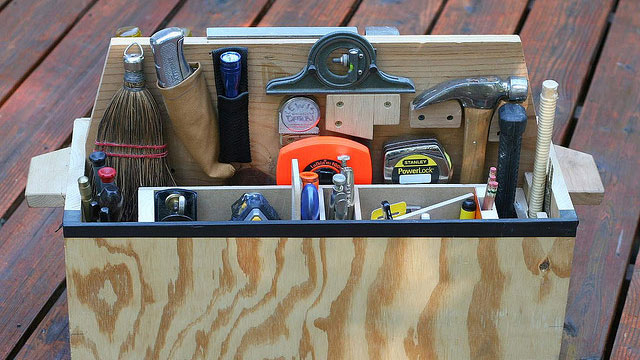
A universal toolbox should include these 10 essential tools:
- Screwdriver set: From prying the lids off of paint cans to opening child-proof battery compartments, screwdrivers are must-have tools. Aim for flat- and Phillips-head screwdrivers in various sizes; you can often buy these in kits. Look for magnetic tips and comfortable grips to make screwing or unscrewing easier. See Art of Manliness’ how to use a screwdriver for more about screwdrivers than you might care to know.
- Claw Hammer: No toolbox would be complete without a solid hammer. One end is used to drive nails in, the other side to pull (usually bent) nails out of wood or a wall. Rubber, plastic or vinyl handles offer shock absorption and a better grip.
- Pliers: Locking, adjustable pliers are very versatile. Because they lock in place, they can be used as a clamp, or, as mentioned above, in lieu of a spanner or wire cutter.
-
Adjustable spanner: An adjustable spanner is more versatile than fixed sizes. You’ll need one to tighten nuts and bolts and loosen plumbing fixtures.
- Tape Measure: You might have heard the saying “measure twice, cut once”. Well, you need a tape measure for that and to do other things such as making sure furniture will fit in a room and measuring windows for blinds.
- Level: No more crookedly-hung photos! A level ensures you don’t hang or install anything (including your flat-screen TV and shelves) less than horizontally perfect. In a pinch you could use one of many mobile apps that serve as a virtual level.
- Utility Knife: For opening boxes, sharpening pencils, and more, the utility knife is a toolbox workhorse. This Old House recommends buying one with built-in blade storage and rubber-covered handles for comfort.
- Torch: You’ll need a torch for your emergency kit anyway, but you could get a dedicated LED light, head lamp, or work lamp to make sure you’re sawing/screwing/nailing or otherwise DIYing correctly in low or no light.
- Electric Drill: Although you can go without a drill for a while or resort to borrowing one when needed, sooner or later, most handypeople find a drill indispensable. Cordless drills are convenient for working anywhere, but the corded kinds cost less and don’t require expensive battery replacements. Whichever type you get, an electric drill not only drills holes and drives screws, but, with different bits, also sands and grinds materials, stirs paint, and even helps out in the kitcheb.
- Hacksaw: A hacksaw cuts through wood and even metal and plastic pipes. Look for the kind with replaceable blades.
Other: A well-equipped toolbox should also include: safety goggles, work gloves, rags, pencil, superglue, and, of course, duct tape and WD-40.
The Enhanced Toolbox
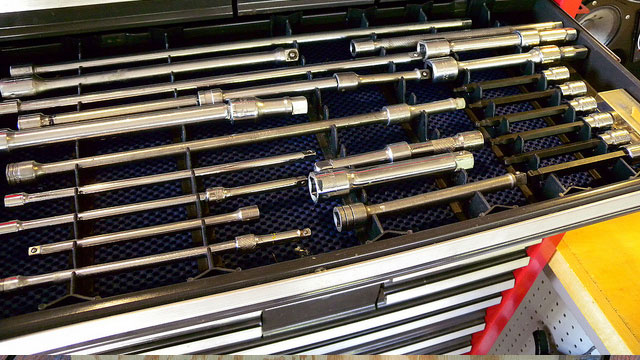
Level up with upgraded versions of the above tools, plus some inexpensive specialty tools for tackling more types of projects.
- Stud Finder: A stud finder will help you secure shelves, cabinets, expensive TVs, etc. to studs in the wall — and avoid surprises when cutting into one.
- Ratcheting screwdriver: This type of screwdriver locks into place when you turn it clockwise and loosens when you turn counter-clockwise, which lessens the stress on your wrist. Most store a variety of screwdriver heads in the handle and may also bend 90 degrees or more for greater versatility.
- Set of pliers: Beyond the adjustable pliers, other pliers to pick up include needle-nose and wire-cutting (or diagonal) pliers, for more exacting gripping work (like fixing jewelry) or, well, cutting wire.
- Socket set: For large projects where you have to tighten or loosen many nuts and bolts, a socket spanner set with a ratcheting handle is the way to go.
- Allen keys: Allen keys are L-shaped tools used to drive bolts and screws with hexagonal sockets in the head. You’ll often find these used in furniture kits (hello IKEA!) and for bike repairs.
- Putty knife: The putty knife, naturally, is for spreading putty (to patch holes in walls, for instance). Available with stiff or rigid blades, it can also be used to scrape off old paint or glue residue, pry up nails or can lids, clean paint smudges, and remove wallpaper.
- Combination Square: When you want to make cuts that are at true 90-degree angles or otherwise precisely measure and mark the squareness of corners, you’ll need a combination square.
- Chisel: A set of sharp chisels comes in handy when you’re working with wood or doing something like changing the deadbolt on your front door (where you need to carve out some part of the wall). There are many types of chisels, made for specialised purposes, but the basic design of them all is the same.
- Crosscut Saw: The jack-of-all-trades saw (what most people imagine first when thinking of the classic saw shape), the crosscut saw is perfect for small jobs like cutting 2x4s and for cutting across wood grain. About.com’s Home Repair site offers advice on different types of crosscut saws.
Other: Wood glue, plumber’s putty, dust mask, voltage tester, wheelbarrow, shovel, rake, step ladder
The Skilled DIYer/Woodworker’s Toolbox
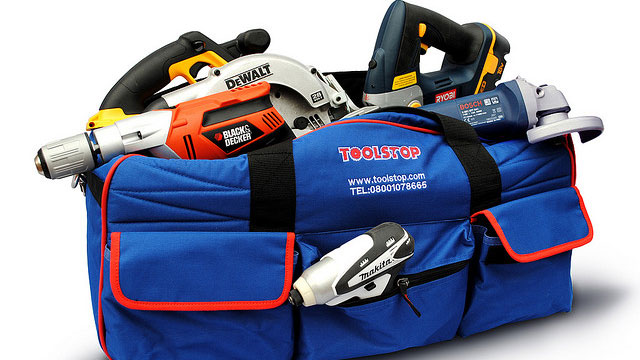
Serious enthusiasts who do many projects around the house will want to invest in more specialised tools or more power tools to do everything more efficiently.
- Crowbar: When you need to pry apart boards, remove stubborn nails, do some heavy lifting, or otherwise break things, reach for the crowbar.
- Rubber Mallet: A rubber mallet lets you hammer or tap without damaging the surface. It comes in handy when installing laminate flooring or ceramic tiles.
- Staple gun: A heavy-duty staple gun doesn’t cost much but has a broad range of applications: everything from roofing and upholstery to hobbies and crafts. It’s like your standard office stapler but more powerful, and comes in manual and electric versions.
- Circular Saw: One of the most common power tools today, the circular saw’s toothed metal cutting disk cuts through masonry, tile, and steel.
- Automatic Nailer: If you’re going to be driving a whole lot of nails, a nail gun will help you save time and effort over using a hammer. Finish nailers are used to nail mouldings and small trim boards (like baseboards), while brad nailers are for thinner or more delicate trim.
- Cordless Dremel Rotary Tool: A Dremel (or other similar rotary tool) may not be a necessity, but it sure comes in handy for a great variety of applications. With different attachments, you can use the power tool for drilling, grinding, sanding, sawing, sharpening, routing, polishing, cleaning, carving and engraving. It’s like a toolbox in itself.
Other: plumb bob or plumb line (a weight on a string for creating a vertical reference line), clamps to hold wood pieces together, sledgehammer, extension ladder, sawhorse or workbench
The lists above should certainly get your toolbox decked out and help you tackle just about any project around your home. For further inspiration (or just plain tools-gawking), check out MythBuster Adam Savage’s list of 300 meticulously-organised tools.
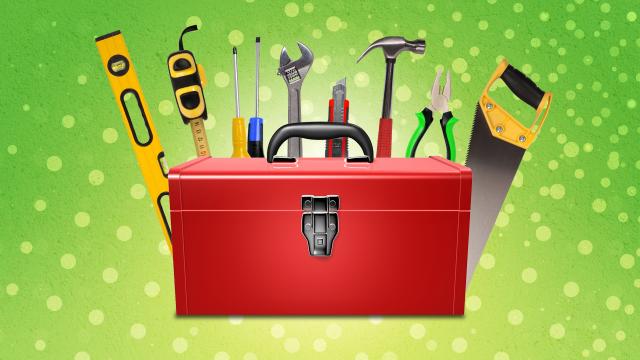
Comments
2 responses to “How To Build The Essential Toolbox For Every Level Of DIY”
Some adjustments to the basic toolset list
Adjustable spanners suck.. Get a spanner set and be happy!
Get some drill bits (the electric drill is pretty useless without them)
And Ear Plugs/muffs to go with your safety glasses PPE isn’t optional, it’s essential!
My workshop is pretty well set up, I own every thing on that list and a fair bit more but I don’t own a roll of duct tape.
I don’t believe in half assing a job that should have been done right the first time.
A basic bench grinder to keep your tools sharp and clean is always handy! And safety glasses, gloves and preferably steel cap boots when using all the tools!??